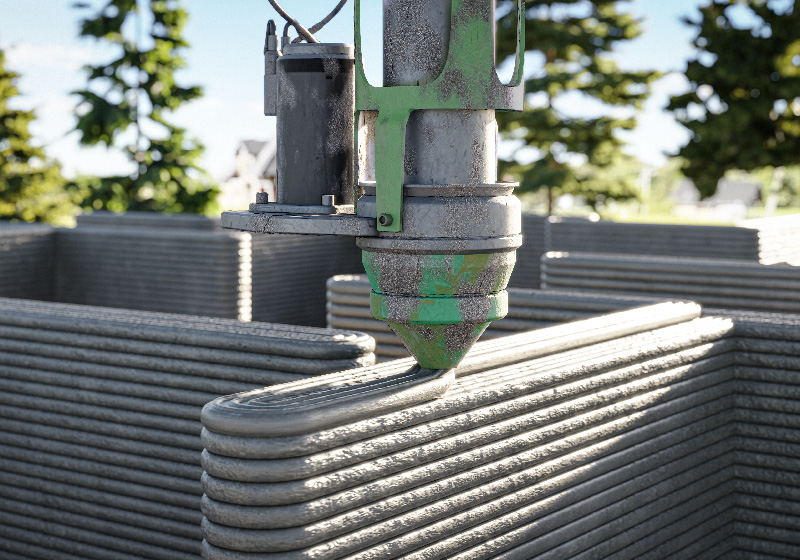A more recent technology that’s been making its rounds by disrupting and inspiring innovations across industries is 3D printing. Glasses, shoes, car parts, prosthetics, and movie props are all being 3D-printed today, and the speculation of how this technology might change people’s everyday lives seems to be at an all-time high. With the speed and ease that common items can be printed, some have started to think even bigger.
Enter businesses like Texas-based ICON, Denmark’s COBOD, and Shanghai’s Winsun, who all believe that 3D printing is the future of home manufacturing. Citing shockingly quick construction times, cheaper costs, and little required human oversight, many believe that 3D-printed homes becoming the norm is less of an “if,” and more of a “when.” So, if you’re curious to find out what your future home will look like, let’s discuss the process of 3D-printed homes!
What Are 3D-Printed Homes?
3D printing homes is actually quite similar to the process used when 3D printing other mundane items. Also known as “additive manufacturing,” 3D printing involves a machine printer containing a robotic arm dispenser, a chosen material to use in the item creation (usually plastic for most things unrelated to building construction), and a blueprint design that directs the machine’s intricate motions. Printing homes works largely the same way – just bigger.
In-home 3D printers are usually around the size of a standard office printer. However, the devices used to construct residential buildings consist of a meters-long frame due to the fact that any 3D printer needs to be larger than whatever it creates. This “macro-printer” squeezes out a paste (usually cement, but sometimes plastic, metal, sand, or clay) which solidifies as walls are slowly built line-by-line and layer-by-layer. The resulting structure is made up of gray, horizontal ridges before specialists then add “second-fix installments,” like plumbing, electrical wiring, doors, and windows.
Today, 3D-printed homes are still quite rare, but many believe that these homes could start popping up around the world in no time. Dubai, for instance, has made the most committed plan, working toward 25% of new buildings 3D-printed by 2030 (read more from journalists over at 3DPrint). Is 3D printing a passing fad, or a realistic answer to today’s housing problems? Let’s review some of the technology’s pros and cons to decide!
What Are The Benefits Of 3D-Printed Homes?
When going to one of the prominent 3D home printing company’s websites, you’ll find plenty of impressive benefits to this new technology, starting with its speed. While traditionally constructed homes can be built in under seven months, 3D printing cuts this time span to under two – with some claiming a print time of a day, or even a few hours! Printers don’t require the same amount of human oversight or the number of laborers and there is less wasted materials during 3D printing, so the prices of constructing these homes also drop.
Quick construction times with affordability? Rightly, many have looked towards the advancements in 3D printing as a possible answer to the housing crisis not just in the United States and Canada, but across the globe. Unfortunately, as can be expected, things are rarely as perfect as they first appear.
What Are The Concerns?
The first clear limitation with 3D homes are their printers. The printers are costly, and there aren’t a lot of them available. On top of this, even the larger 3D home printers aren’t large enough to construct multi-family homes or many commercial buildings. In a world where skyscrapers are so common, this seriously reduces the current usefulness of these tools as a practical construction option. The fact is that most 3D buildings that have been shown off to date are modestly sized, modern structures with admittedly eye-catching curvilinear designs.
On top of this, construction-scale 3D printing companies have a negative reputation of poor transparency on their projects. While they might advertise full construction in a single day, closer inspection reveals that they’re really just referring to printing the walled structure without including the time to add interior and exterior finishes, the foundation, the roof, windows, doors, and other key home systems like plumbing and electricity. Additionally, these structures are usually printed off-site, meaning they need to be transported and reassembled in the home’s final location later on.
Other benefits may also be negative attributes as well, like the elimination of laborer jobs. While this technique might add new jobs managing the equipment, 3D printing seems to take away more on-site jobs than it adds. Since this technology and process is so new, learning how well these homes hold up over time is also up for debate. As many argue today (such as Jack Morley, former architect, on Archtizer), 3D-printed buildings might be more sizzle than substance at the moment.
What Is The Outlook For 3D Home-Printing?
To answer the question posed in the title: no. Your next home likely will not be 3D-printed. However, the technology does offer a number of benefits that may be added to the overall toolkit of home construction over the next few decades. Further innovations like the ability to use wood and other bioplastics can also improve 3D printing’s ecological footprint, making it even more of a draw.
In all likelihood, 3D-printed homes will likely continue to be an occasional oddity best used when the conditions are just right, or traditional construction options are limited. For instance, per NASA, there could be future bases on the Moon and Mars created with 3D printing construction.
We, at NPI, love to keep up with all of the latest trends and innovations in home construction, maintenance, and design! To make sure your home is up to snuff in every weather, remember to schedule your annual home maintenance inspection today!



